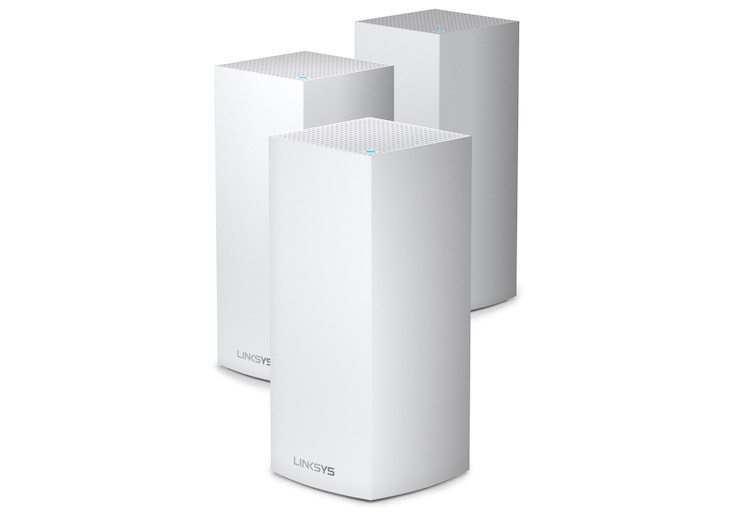Mesh technology is increasingly being widely applied to eliminate Wi-Fi "dead spots" in large, dense homes.
The Linksys Velop MX12600 Wi-Fi transmitter is named after the maximum total speed of the entire system, which is 12,600Mbps. It includes three Velop MX4200 transmitters with a maximum speed of 4,200Mbps/transmitter, each capable of broadcasting Wi-Fi for an area of up to 180m2 - meaning the total of the entire Velop MX12600 is 540m2 . And of course, like any other wireless transmitter, the coverage range will be reduced more or less when it has to go through walls and floors.
Velop MX12600 Mesh Wi-Fi Router.
From real-life situations encountered, it must be affirmed that Velop MX12600 is a very worthy solution for houses with weak signal areas or worse, Wi-Fi "dead spots".
As in the case of the writer living in a 90m2 apartment (2 bedrooms) or the case of a colleague living in a 3-storey townhouse with a total floor area of about 400m2 . With the design of the fiber optic cable in the living room very far from the master bedroom or on the ground floor, people living in the above houses have had to go through extremely frustrating days when the Wi-Fi network drops up and down in many locations in the house.
To solve the problem in the apartment, the writer tried using a "genuine" Xiaomi router that costs more than 2 million VND, but catching Wi-Fi in the master room was still hopeless because it was not only far away but also had double walls. Meanwhile, in the townhouse, the writer's colleague manually installed 4 repeaters in the house (the total investment was also about 2 million VND) but still could not cover all the recessed areas, not to mention it created too many different Wi-Fi hotspots, causing countless inconveniences.
Until switching to the Linksys Velop MX12600 , all problems were solved in a "jiffy". The "magic" of the MX12600 lies in the Mesh technology that allows the transmitters to connect together into a unified network with almost zero latency. Thanks to that, the user's device moves anywhere in the broadcasting space and has a seamless Internet connection . In addition, the Velop MX12600's ability to penetrate walls and floors is also very impressive.
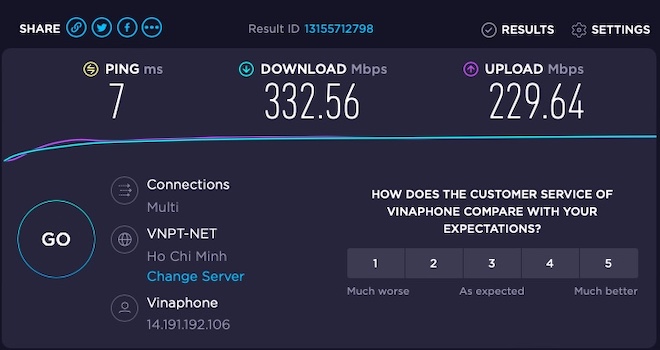
Internet speed in a Wi-Fi hotspot is significantly improved thanks to the Velop MX12600.
For example, in the case of an apartment, instead of having to find a way to change the location of the modem and router to the center of the apartment - which is very difficult to do, the writer only needs to install a Velop MX4200 unit right at the default location of the apartment. Then, install an additional Velop MX4200 unit near the door of each bedroom and you're done. In the writer's case, the entire Velop MX12600 unit is a bit redundant, in fact, only 2 Velop MX4200 units (living room and master bedroom) are enough.
Velop MX4200 Details, this router is equipped with a 1.4GHz quad-core processor, 512MB RAM, 3 LAN ports and 1 WAN port (10/100/1,000Mbps), along with a USB 3.0 port to add a network hard drive (NAS). It is capable of broadcasting Wi-Fi on a 2.4GHz band (maximum speed of 600Mbps) and two 5GHz bands (maximum speed of 1,200Mbps and 2,400Mbps), using the Wi-Fi 6 standard with MU-MIMO and Intelligent Mesh technology. The product integrates Beamforming technology for centralized broadcasting and Seamless Roaming technology for uninterrupted roaming.
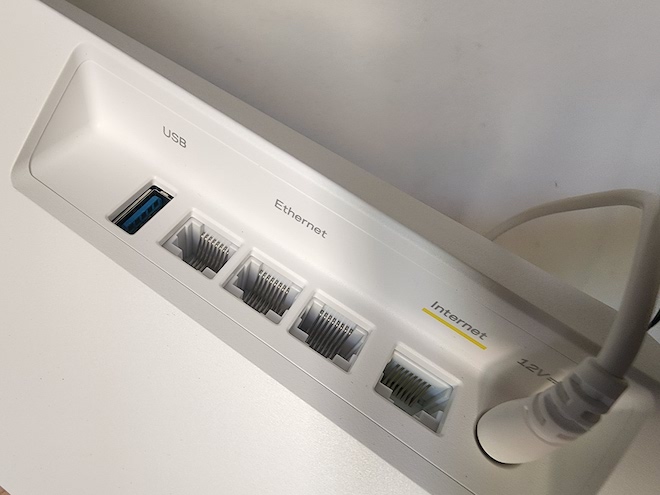
Connection ports of MX4200.
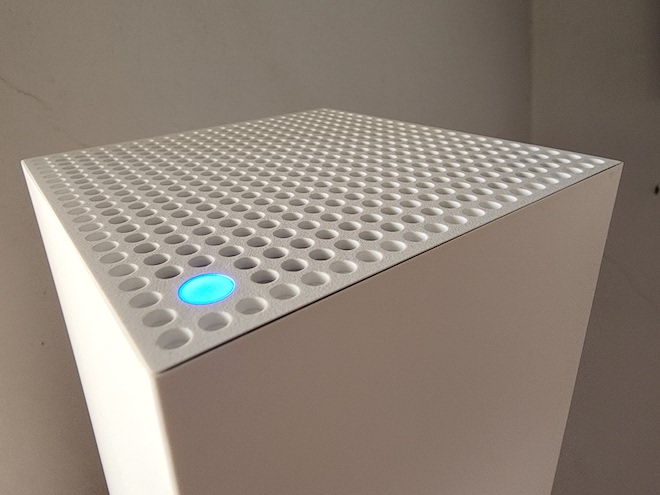
Signal light on top.
In this article, the author will not go into too much detail about the technical specifications of the MX4200, but will instead evaluate the convenience and practical efficiency that this transmitter in particular and the MX12600 system in general bring. In short, the MX12600 is very practical, easy to install, set up and comes with many management features via the Linksys application (for Android and iOS).
Users just need to plug in the MX4200 and place the transmitter in a suitable location for the space, wait a few tens of seconds for the signal light on the top to show pink and it is ready for setup. Of course, the first MX4200 in the system must be connected by RJ45 network cable to the modem.
On a smartphone with Bluetooth enabled, the user installs the Linksys app, registers for a Linksys account and logs in. Then, select Create Another Network > Let's Go > Whole Home Mesh WiFi (Velop) > Next > Next > It's In the Open > It's Connected, then waits for the app to automatically search and perform some initial settings.
The user's task is simply to set the Wi-Fi name and password, choose the location of the transmitter (living room, bedroom or kitchen,...) for easy management.
After completing the setup of the first node (called the primary node), the user repeats the process for the two secondary nodes (later, additional secondary nodes can be purchased to expand if needed). The only difference is the step of selecting "Add Another Node to [Created Wi-Fi Name]", instead of Create Another Network.
Done, the Wi-Fi Mesh network is ready to serve users with wireless Internet covering the entire house, the whole garden with only one Wi-Fi network name. The MX12600 system is very smart, it will automatically select the node, specifically the MX4200, that provides the most optimal connection for each device (smartphone, laptop, TV, ...). Whenever the device moves to an area that is more suitable for another node, the node switching process will take place silently, with almost no delay. In addition, the MX12600 also automatically decides the appropriate connection band for the device.
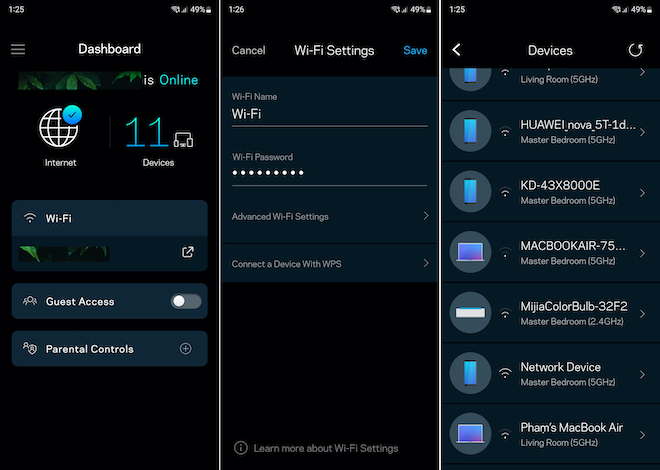
Management interface on Linksys app.
With a smaller usable space than the MX12600's capabilities, the writer always seems to experience high-speed, low-latency Wi-Fi on the 5GHz band when using smartphones and laptops,... (except for some IoT devices that can only connect to the 2.4GHz band such as surveillance cameras, air conditioners,...).
In particular, the MX12600 with Wi-Fi 6 technology can handle heavy tasks such as 4K streaming, PlayStation, etc. This product is also designed to give high priority to Microsoft Teams and Zoom when making group calls or online meetings and conferences. In addition to the above services, users can enable priority mode for any transmission channel via the Linksys application. Therefore, the MX12600 is very suitable for users who often work from home.
During use, if you want to change the Wi-Fi name or password, view the status of each node or the list of devices connected to the network (which brand of device, connected to which node, using which frequency band, what is the IP address,...), users can do it easily on the Linksys application or on the web.
Some notable features on the Linksys app are choosing which devices get priority over others, and setting up content management for children's devices (blocking specific websites, pausing connections immediately, or scheduling connection pauses). In particular, the MX12600 can be combined with Apple HomeKit to add a layer of security to the smart home, thanks to which a "firewall" will protect devices in the HomeKit ecosystem from all prying eyes.
Overall, the writer is really impressed with the MX12600 when it helps maximize the power of the fiber optic Internet connection at home. Switching from the default Wi-Fi modem of the network operator to the MX12600 also helps to significantly improve the latency when playing Lien Quan Mobile or FIFA Online 4. However, the management features on the Linksys application as well as the web platform are not as rich as some other brands that the writer has experienced.
In addition, although using hidden antennas, the size of each MX4200 is difficult to be large. Finished with a luxurious white design, vents and signal indicator lights on the top (purple is setting up, blue is normal use, red is lost Internet connection, orange is lost connection with another node), users can delicately decorate the space so that the MX4200 becomes a decoration in the room.

